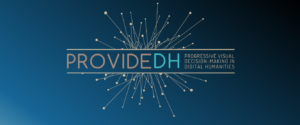LyricSIM: A novel Dataset and Benchmark for Similarity Detection in Spanish Song LyricS
Making the Whole Greater than the Sum of its Parts
Analyzing and Visualizing Uncertain Knowledge: The Use of TEI Annotations in the PROVIDEDH Open Science Platform
A project review under the focus of ‘complexities’ on the example of exploreAT!
Evaluating a Taxonomy of Textual Uncertainty for Collaborative Visualisation in the Digital Humanities
Playing Design: A Case Study on Applying Gamification to Construct a Serious Game with Youngsters at Social Risk
This article reports on the experience of co-designing an educational video game aimed at promoting good dietary habits in youngsters and fostering Sustainable Development Goals (SDGs), such as SDG 3 (Good Health and Well-Being), SDG 10 (Reduced Inequalities), and SDG 17 (Partnerships for the Goals). To ensure the quality of the results, we developed a methodology under a social innovation paradigm that enabled the co-creation of the game. The methodology was driven by a series of three workshops, during which we adopted several different gamification strategies to support a Participatory Design (PD) process with the stakeholders, a group of local pre-teen and teen girls at social risk (N = 22). Captured requirements materialized into intermediate prototype evaluations that motivated a progressive refinement of the game.
PROgressive VIsual DEcision-Making in Digital Humanities (PROVIDEDH)

The PROgressive VIsual DEcision-Making in Digital Humanities (PROVIDEDH) project is a four-year project funded within the CHIST-ERA call 2016 for the topic “Visual Analytics for Decision Making under Uncertainty – VADMU.” The project aims to give Digital Humanities (DH) scholars a space to explore and assess the completeness and evolution of digital research objects, the degree of uncertainty that the models applied to the data incorporate, and to share their perspectives and insights with the project’s broad range of stakeholders.
The project’s goal is realisable through the development of a wide spectrum of outcomes, ranging from recommendations and reports, to a multimodal collaborative platform for the progressive visual analysis of different DH collections, both for scholars and citizen humanists. The project brings technical experts together with leading digital humanists with a range of expertise and is supported by Winnovation, one of the leading European consulting agencies on Open Innovation. The developed systems will be available for external stakeholders to use and our open-source approach will promote their collaboration with the project and its partners.
Visualización de incertidumbre en grafos sociales para la exploración de bibliotecas digitales
Supporting Methodology Transfer in Visualization Research with Literature-Based Discovery and Visual Text Analytics
Defragmenting Research Areas with Knowledge Visualization and Visual Text Analytics
Theme Article: Art and Cultural Heritage
Pilaster: A Collection of Citation Metadata Extracted From Publications on Visualization for the Digital Humanities
GlassViz: Visualizing Automatically-Extracted Entry Points for Exploring Scientific Corpora in Problem-Driven Visualization Research
Glassviz: Visualizing Automatically-extracted Entry Points for Exploringscientific Corpora in Problem-driven Visualization Research
A Data-Driven Introduction to Authors, Readings and Techniques in Visualization for the Digital Humanities
The newly rediscovered frontier between data visualization and the digital humanities has proven to be an exciting field of experimentation for scholars from both disciplines. This fruitful collaboration is attracting researchers from other areas of science who may be willing to create visual analysis tools that promote humanities research in its many forms. However, as the collaboration grows in complexity, it may become intimidating for these scholars to get engaged in the discipline. To facilitate this task, we have built an introduction to visualization for the digital humanities that sits on a data-driven stance adopted by the authors. In order to construct a dataset representative of the discipline, we analyze citations from a core corpus on 300 publications in visualization for the humanities obtained from recent editions of the InfoVis Vis4DH workshop, the ADHO Digital Humanities Conference, and the specialized digital humanities journal Digital Humanities Quarterly. From here, we extract referenced works and analyze more than 1900 publications in search of citation patterns, prominent authors in the field, and other interesting insights. Finally, following the path set by other researchers in the visualization and Human-Computer Interaction (HCI) communities, we analyze paper keywords to identify significant themes and research opportunities in the field.
